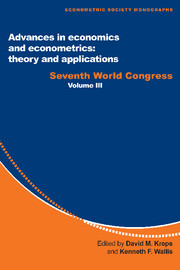Book contents
- Frontmatter
- 1 Causal analysis and statistical inference on possibly non-stationary time series
- 2 Cointegration, long-run comovements, and long-horizon forecasting
- 3 Testing and measurement in competition models
- 4 Empirical equilibrium search models
- 5 Posterior simulators in econometrics
- 6 Restricted least squares subject to monotonicity and concavity constraints
- 7 Bootstrap methods in econometrics: theory and numerical performance
- 8 Econometric models of option pricing errors
- 9 New minimum chi-square methods in empirical
- Index
5 - Posterior simulators in econometrics
Published online by Cambridge University Press: 05 January 2013
- Frontmatter
- 1 Causal analysis and statistical inference on possibly non-stationary time series
- 2 Cointegration, long-run comovements, and long-horizon forecasting
- 3 Testing and measurement in competition models
- 4 Empirical equilibrium search models
- 5 Posterior simulators in econometrics
- 6 Restricted least squares subject to monotonicity and concavity constraints
- 7 Bootstrap methods in econometrics: theory and numerical performance
- 8 Econometric models of option pricing errors
- 9 New minimum chi-square methods in empirical
- Index
Summary
INTRODUCTION
Econometrics is the discipline of using data to revise beliefs about economic issues. In Bayesian econometrics the revision is conducted in accordance with the laws of probability, conditional on what has been observed. The normative appeal of Bayesian econometrics is the same as that of expected utility maximization and Bayesian learning, the dominant paradigms in economic theory. The questions that econometrics ultimately addresses are similar to those faced by economic agents in models, as well. Given the observed data, what decisions should be made? After bringing data to bear on two alternative models, how is their relative plausibility changed? Having updated a dataset how should decisions be changed? Any survey of the introductory and concluding sections of papers in the academic literature should provide more examples and illustrate the process of formally or informally updating beliefs.
Until quite recently applied Bayesian econometrics was undertaken largely by those primarily concerned with contributing to the theory, and the proportion of applied work that was formally Bayesian was rather small (Poirier (1989, 1992)). There are several reasons for this. First, Bayesian econometrics demands both a likelihood function and a prior distribution, whereas non-Bayesian methods do not. Second, the subjective prior distribution has to be defended, and if the reader (or worse, the editor) does not agree then, the work may be ignored. Third, most posterior moments cannot be obtained anyway because the requisite integrals cannot be evaluated.
- Type
- Chapter
- Information
- Advances in Economics and Econometrics: Theory and ApplicationsSeventh World Congress, pp. 128 - 165Publisher: Cambridge University PressPrint publication year: 1997
- 22
- Cited by

